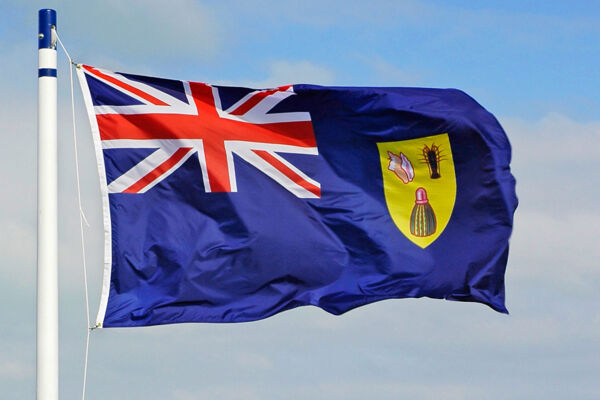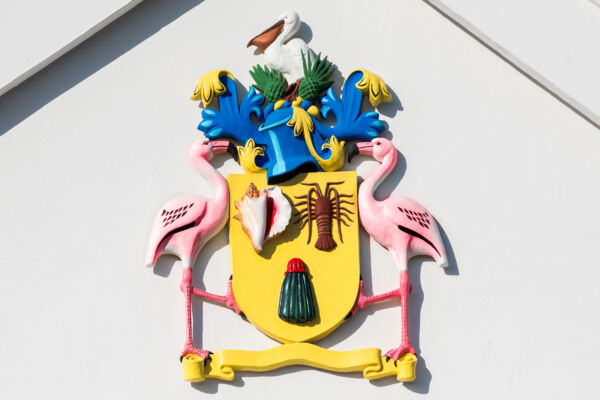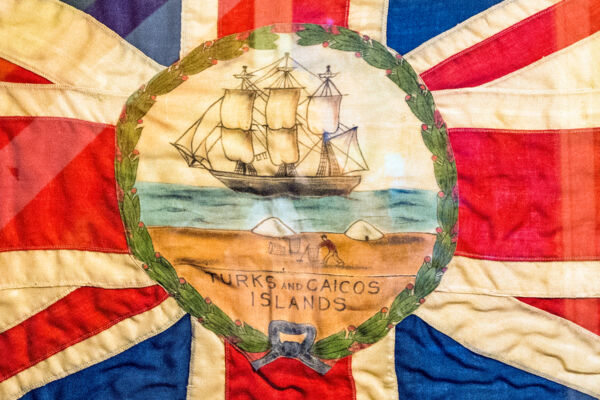The Flag of the Turks and Caicos

What is on the Turks and Caicos Flag?
The Turks and Caicos is a British Overseas Territory (along with 14 other countries including Gibraltar, Bermuda, and the Falkland Islands), and accordingly, the Union Jack occupies the upper left corner of the flag. The corresponding yellow coat of arms shield on the right of the flag displays a queen conch shell, the spiny lobster, and the Turk's head cacti.
The flag is based on the British Blue Ensign (blue field with the Union Jack in the top-left corner), with the territory’s coat of arms on the right. This is the case with many of the British Overseas Territories, such as the Cayman Islands and British Virgin Islands (a notable exception is Bermuda, which uses the Red Ensign).
The queen conch and spiny lobster have always been very important food sources to those living in the Turks and Caicos, especially before the last few decades.
The Turk's head cacti (Melocactus intortous) is a unique and stubby barrel cacti that are indigenous to the Turks and Caicos and other islands in the Caribbean.
The cactus was likely selected for the flag as it may have been thought that it accounted for the “Turks” in Turks and Caicos. Evidence suggests that our archipelago wasn’t in fact named after the cacti, but rather after pirates. In previous centuries, “Turk” was a synonym for “pirate” due to Islamic corsairs that preyed on the Mediterranean, Africa, and Europe. The Turks and Caicos was once a haven for pirates, and Turks was written on charts by an early mapmaker to serve as a warning. The name has stuck ever since.
The current Turks and Caicos flag was adopted in 1968.
The Turks and Caicos Coat of Arms

The Turks and Caicos coat of arms, used by government departments and agencies, also bears a similarity to the flag.
The crest features the same conch, lobster, and cacti shield as on the flag, in addition to a standing Caribbean flamingo on either side of the shield, a heraldic helmet, and a brown pelican perched on the helmet. Two sisal plants flank the pelican, which are a testament to the sisal fiber industry that existed in the late 1800s and early 1900s. It’s common to see the British flag fly alongside the Turks and Caicos flag, such as at the airport.
Historical Flags
The Turks and Caicos Igloo Flag
One of the best-known historical Turks and Caicos flags was the igloo flag. In 1869, the Executive Council in Grand Turk responded to a request by the Home Secretary of the United Kingdom to “sketch of such badge as it may be proposed should be emblazoned on the flag authorized by Her Majesty to be used in the Colony”.

A design featuring a ship, a salt raker, and salt piles was created and sent to be transformed into the flag. At the time, the sea salt industry was all-important and the primary source of income for the Turks and Caicos.
Unfortunately, giant piles of salt were a foreign concept to the flag maker in London, and he interpreted them as igloos! To complete the abodes, he even added doors! Perhaps the famous tragedy of Captain Sir John Franklin’s expedition to the Arctic in 1845 influenced the mistake, as the sketched design and subsequent flag bear a resemblance to the Arctic.
The igloo flag was used for 99 years, until the modern flag was adopted.
Governor’s Flag
The governors of the British Overseas Territories also have their own flag, which is a Union Jack with a small central disk containing the shield of the territory they represent.
Criminalization of Commercial Use of the Flag
In 2016, the Government passed the Flag and National Symbols (Regulations) Ordinance 2016, which makes it a criminal offense to use the flag for commercial goods (such as souvenir flags, coffee mugs, and pins) without a license. This annual license must be obtained for each and every type of good sold.
The penalty for contravening this is a $5,000 fine and/or a six-month jail sentence.
Politicians are generally exempt from this law due to a carve-out that exempt persons campaigning or procuring the election of a person.
